Improving Recruitment, Selection and Training at Nestle Globally
VerifiedAdded on 2021/02/19
|21
|5252
|32
Report
AI Summary
This report examines how multinational companies, specifically Nestle, improve their recruitment, selection, and training processes to meet international requirements in a globalized market. It begins with an introduction to globalization and its impact on businesses, followed by the aims and objectives of the research, focusing on refining these processes for Nestle. The report includes a detailed project management plan covering cost, scope, time, quality, communication, risks, and resources. A work breakdown structure and Gantt chart are also provided to illustrate project organization and timelines. The research methodology employs both qualitative and quantitative methods, utilizing primary and secondary data collection techniques, including questionnaires. The report analyzes the research findings, provides recommendations, and concludes with a reflection on the research process. References and an appendix are included to support the findings.

Managing a Successful
Business Project
Business Project
Paraphrase This Document
Need a fresh take? Get an instant paraphrase of this document with our AI Paraphraser
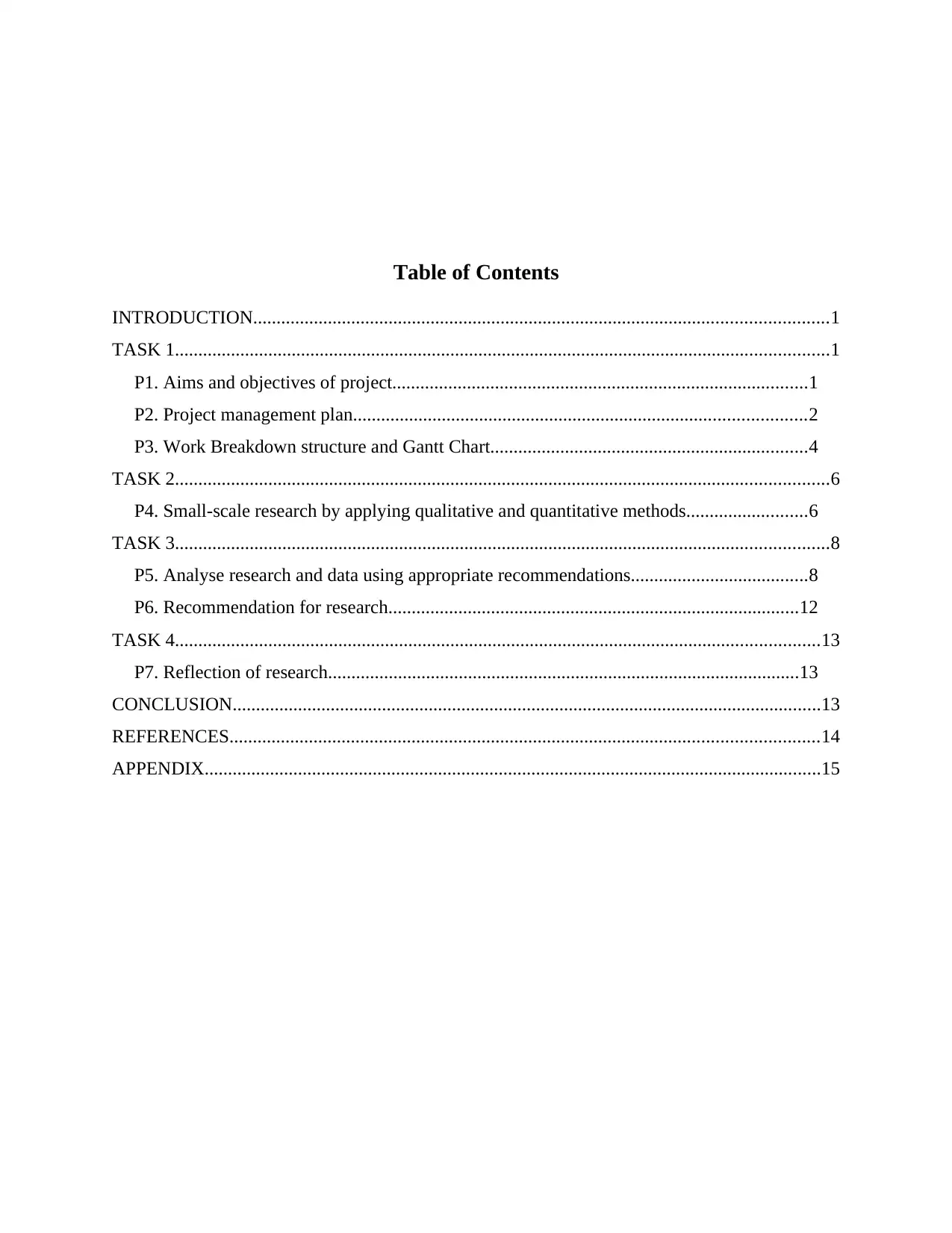
Table of Contents
INTRODUCTION...........................................................................................................................1
TASK 1............................................................................................................................................1
P1. Aims and objectives of project.........................................................................................1
P2. Project management plan.................................................................................................2
P3. Work Breakdown structure and Gantt Chart....................................................................4
TASK 2............................................................................................................................................6
P4. Small-scale research by applying qualitative and quantitative methods..........................6
TASK 3............................................................................................................................................8
P5. Analyse research and data using appropriate recommendations......................................8
P6. Recommendation for research........................................................................................12
TASK 4..........................................................................................................................................13
P7. Reflection of research.....................................................................................................13
CONCLUSION..............................................................................................................................13
REFERENCES..............................................................................................................................14
APPENDIX....................................................................................................................................15
INTRODUCTION...........................................................................................................................1
TASK 1............................................................................................................................................1
P1. Aims and objectives of project.........................................................................................1
P2. Project management plan.................................................................................................2
P3. Work Breakdown structure and Gantt Chart....................................................................4
TASK 2............................................................................................................................................6
P4. Small-scale research by applying qualitative and quantitative methods..........................6
TASK 3............................................................................................................................................8
P5. Analyse research and data using appropriate recommendations......................................8
P6. Recommendation for research........................................................................................12
TASK 4..........................................................................................................................................13
P7. Reflection of research.....................................................................................................13
CONCLUSION..............................................................................................................................13
REFERENCES..............................................................................................................................14
APPENDIX....................................................................................................................................15
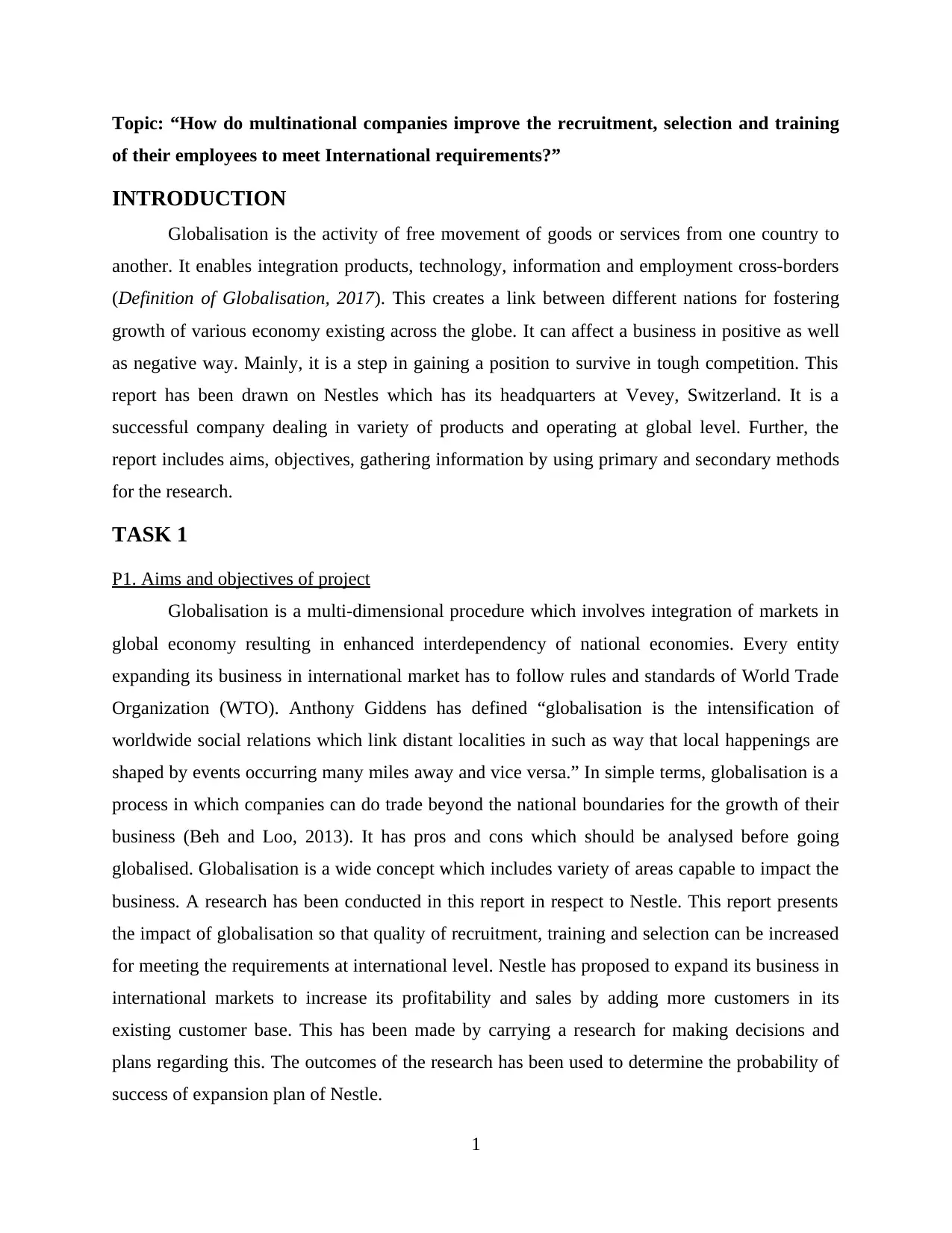
Topic: “How do multinational companies improve the recruitment, selection and training
of their employees to meet International requirements?”
INTRODUCTION
Globalisation is the activity of free movement of goods or services from one country to
another. It enables integration products, technology, information and employment cross-borders
(Definition of Globalisation, 2017). This creates a link between different nations for fostering
growth of various economy existing across the globe. It can affect a business in positive as well
as negative way. Mainly, it is a step in gaining a position to survive in tough competition. This
report has been drawn on Nestles which has its headquarters at Vevey, Switzerland. It is a
successful company dealing in variety of products and operating at global level. Further, the
report includes aims, objectives, gathering information by using primary and secondary methods
for the research.
TASK 1
P1. Aims and objectives of project
Globalisation is a multi-dimensional procedure which involves integration of markets in
global economy resulting in enhanced interdependency of national economies. Every entity
expanding its business in international market has to follow rules and standards of World Trade
Organization (WTO). Anthony Giddens has defined “globalisation is the intensification of
worldwide social relations which link distant localities in such as way that local happenings are
shaped by events occurring many miles away and vice versa.” In simple terms, globalisation is a
process in which companies can do trade beyond the national boundaries for the growth of their
business (Beh and Loo, 2013). It has pros and cons which should be analysed before going
globalised. Globalisation is a wide concept which includes variety of areas capable to impact the
business. A research has been conducted in this report in respect to Nestle. This report presents
the impact of globalisation so that quality of recruitment, training and selection can be increased
for meeting the requirements at international level. Nestle has proposed to expand its business in
international markets to increase its profitability and sales by adding more customers in its
existing customer base. This has been made by carrying a research for making decisions and
plans regarding this. The outcomes of the research has been used to determine the probability of
success of expansion plan of Nestle.
1
of their employees to meet International requirements?”
INTRODUCTION
Globalisation is the activity of free movement of goods or services from one country to
another. It enables integration products, technology, information and employment cross-borders
(Definition of Globalisation, 2017). This creates a link between different nations for fostering
growth of various economy existing across the globe. It can affect a business in positive as well
as negative way. Mainly, it is a step in gaining a position to survive in tough competition. This
report has been drawn on Nestles which has its headquarters at Vevey, Switzerland. It is a
successful company dealing in variety of products and operating at global level. Further, the
report includes aims, objectives, gathering information by using primary and secondary methods
for the research.
TASK 1
P1. Aims and objectives of project
Globalisation is a multi-dimensional procedure which involves integration of markets in
global economy resulting in enhanced interdependency of national economies. Every entity
expanding its business in international market has to follow rules and standards of World Trade
Organization (WTO). Anthony Giddens has defined “globalisation is the intensification of
worldwide social relations which link distant localities in such as way that local happenings are
shaped by events occurring many miles away and vice versa.” In simple terms, globalisation is a
process in which companies can do trade beyond the national boundaries for the growth of their
business (Beh and Loo, 2013). It has pros and cons which should be analysed before going
globalised. Globalisation is a wide concept which includes variety of areas capable to impact the
business. A research has been conducted in this report in respect to Nestle. This report presents
the impact of globalisation so that quality of recruitment, training and selection can be increased
for meeting the requirements at international level. Nestle has proposed to expand its business in
international markets to increase its profitability and sales by adding more customers in its
existing customer base. This has been made by carrying a research for making decisions and
plans regarding this. The outcomes of the research has been used to determine the probability of
success of expansion plan of Nestle.
1
⊘ This is a preview!⊘
Do you want full access?
Subscribe today to unlock all pages.

Trusted by 1+ million students worldwide
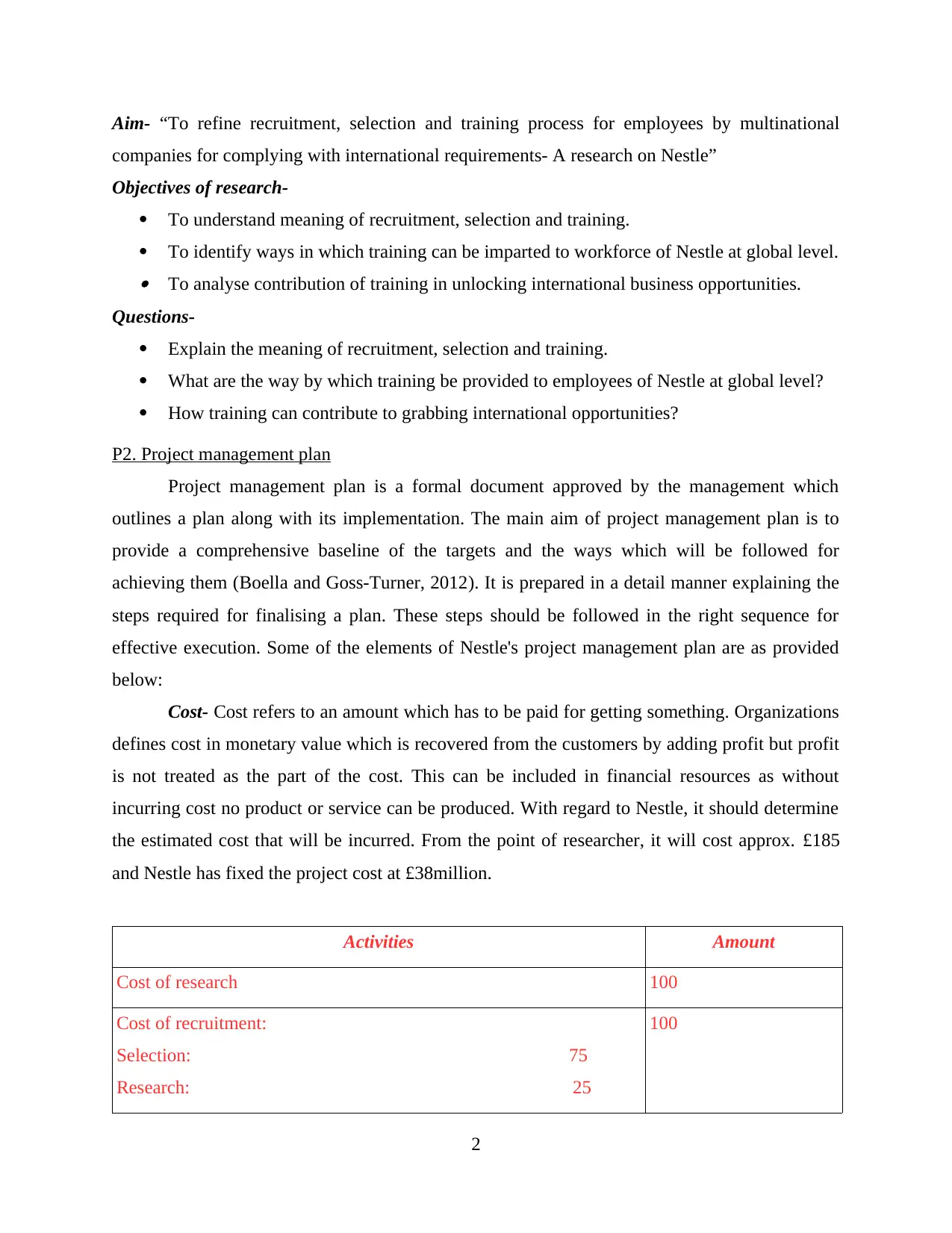
Aim- “To refine recruitment, selection and training process for employees by multinational
companies for complying with international requirements- A research on Nestle”
Objectives of research-
To understand meaning of recruitment, selection and training.
To identify ways in which training can be imparted to workforce of Nestle at global level. To analyse contribution of training in unlocking international business opportunities.
Questions-
Explain the meaning of recruitment, selection and training.
What are the way by which training be provided to employees of Nestle at global level?
How training can contribute to grabbing international opportunities?
P2. Project management plan
Project management plan is a formal document approved by the management which
outlines a plan along with its implementation. The main aim of project management plan is to
provide a comprehensive baseline of the targets and the ways which will be followed for
achieving them (Boella and Goss-Turner, 2012). It is prepared in a detail manner explaining the
steps required for finalising a plan. These steps should be followed in the right sequence for
effective execution. Some of the elements of Nestle's project management plan are as provided
below:
Cost- Cost refers to an amount which has to be paid for getting something. Organizations
defines cost in monetary value which is recovered from the customers by adding profit but profit
is not treated as the part of the cost. This can be included in financial resources as without
incurring cost no product or service can be produced. With regard to Nestle, it should determine
the estimated cost that will be incurred. From the point of researcher, it will cost approx. £185
and Nestle has fixed the project cost at £38million.
Activities Amount
Cost of research 100
Cost of recruitment:
Selection: 75
Research: 25
100
2
companies for complying with international requirements- A research on Nestle”
Objectives of research-
To understand meaning of recruitment, selection and training.
To identify ways in which training can be imparted to workforce of Nestle at global level. To analyse contribution of training in unlocking international business opportunities.
Questions-
Explain the meaning of recruitment, selection and training.
What are the way by which training be provided to employees of Nestle at global level?
How training can contribute to grabbing international opportunities?
P2. Project management plan
Project management plan is a formal document approved by the management which
outlines a plan along with its implementation. The main aim of project management plan is to
provide a comprehensive baseline of the targets and the ways which will be followed for
achieving them (Boella and Goss-Turner, 2012). It is prepared in a detail manner explaining the
steps required for finalising a plan. These steps should be followed in the right sequence for
effective execution. Some of the elements of Nestle's project management plan are as provided
below:
Cost- Cost refers to an amount which has to be paid for getting something. Organizations
defines cost in monetary value which is recovered from the customers by adding profit but profit
is not treated as the part of the cost. This can be included in financial resources as without
incurring cost no product or service can be produced. With regard to Nestle, it should determine
the estimated cost that will be incurred. From the point of researcher, it will cost approx. £185
and Nestle has fixed the project cost at £38million.
Activities Amount
Cost of research 100
Cost of recruitment:
Selection: 75
Research: 25
100
2
Paraphrase This Document
Need a fresh take? Get an instant paraphrase of this document with our AI Paraphraser
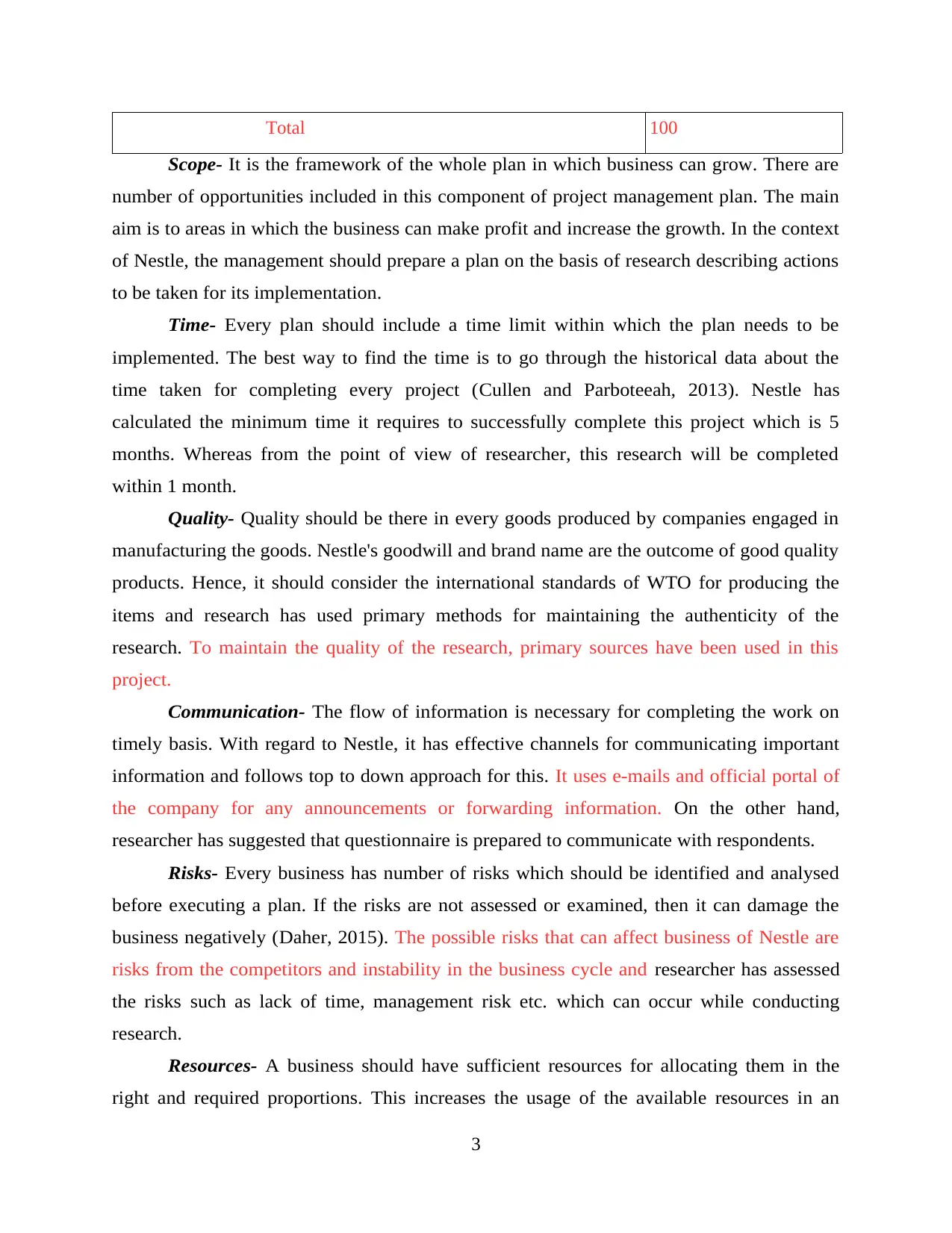
Total 100
Scope- It is the framework of the whole plan in which business can grow. There are
number of opportunities included in this component of project management plan. The main
aim is to areas in which the business can make profit and increase the growth. In the context
of Nestle, the management should prepare a plan on the basis of research describing actions
to be taken for its implementation.
Time- Every plan should include a time limit within which the plan needs to be
implemented. The best way to find the time is to go through the historical data about the
time taken for completing every project (Cullen and Parboteeah, 2013). Nestle has
calculated the minimum time it requires to successfully complete this project which is 5
months. Whereas from the point of view of researcher, this research will be completed
within 1 month.
Quality- Quality should be there in every goods produced by companies engaged in
manufacturing the goods. Nestle's goodwill and brand name are the outcome of good quality
products. Hence, it should consider the international standards of WTO for producing the
items and research has used primary methods for maintaining the authenticity of the
research. To maintain the quality of the research, primary sources have been used in this
project.
Communication- The flow of information is necessary for completing the work on
timely basis. With regard to Nestle, it has effective channels for communicating important
information and follows top to down approach for this. It uses e-mails and official portal of
the company for any announcements or forwarding information. On the other hand,
researcher has suggested that questionnaire is prepared to communicate with respondents.
Risks- Every business has number of risks which should be identified and analysed
before executing a plan. If the risks are not assessed or examined, then it can damage the
business negatively (Daher, 2015). The possible risks that can affect business of Nestle are
risks from the competitors and instability in the business cycle and researcher has assessed
the risks such as lack of time, management risk etc. which can occur while conducting
research.
Resources- A business should have sufficient resources for allocating them in the
right and required proportions. This increases the usage of the available resources in an
3
Scope- It is the framework of the whole plan in which business can grow. There are
number of opportunities included in this component of project management plan. The main
aim is to areas in which the business can make profit and increase the growth. In the context
of Nestle, the management should prepare a plan on the basis of research describing actions
to be taken for its implementation.
Time- Every plan should include a time limit within which the plan needs to be
implemented. The best way to find the time is to go through the historical data about the
time taken for completing every project (Cullen and Parboteeah, 2013). Nestle has
calculated the minimum time it requires to successfully complete this project which is 5
months. Whereas from the point of view of researcher, this research will be completed
within 1 month.
Quality- Quality should be there in every goods produced by companies engaged in
manufacturing the goods. Nestle's goodwill and brand name are the outcome of good quality
products. Hence, it should consider the international standards of WTO for producing the
items and research has used primary methods for maintaining the authenticity of the
research. To maintain the quality of the research, primary sources have been used in this
project.
Communication- The flow of information is necessary for completing the work on
timely basis. With regard to Nestle, it has effective channels for communicating important
information and follows top to down approach for this. It uses e-mails and official portal of
the company for any announcements or forwarding information. On the other hand,
researcher has suggested that questionnaire is prepared to communicate with respondents.
Risks- Every business has number of risks which should be identified and analysed
before executing a plan. If the risks are not assessed or examined, then it can damage the
business negatively (Daher, 2015). The possible risks that can affect business of Nestle are
risks from the competitors and instability in the business cycle and researcher has assessed
the risks such as lack of time, management risk etc. which can occur while conducting
research.
Resources- A business should have sufficient resources for allocating them in the
right and required proportions. This increases the usage of the available resources in an
3
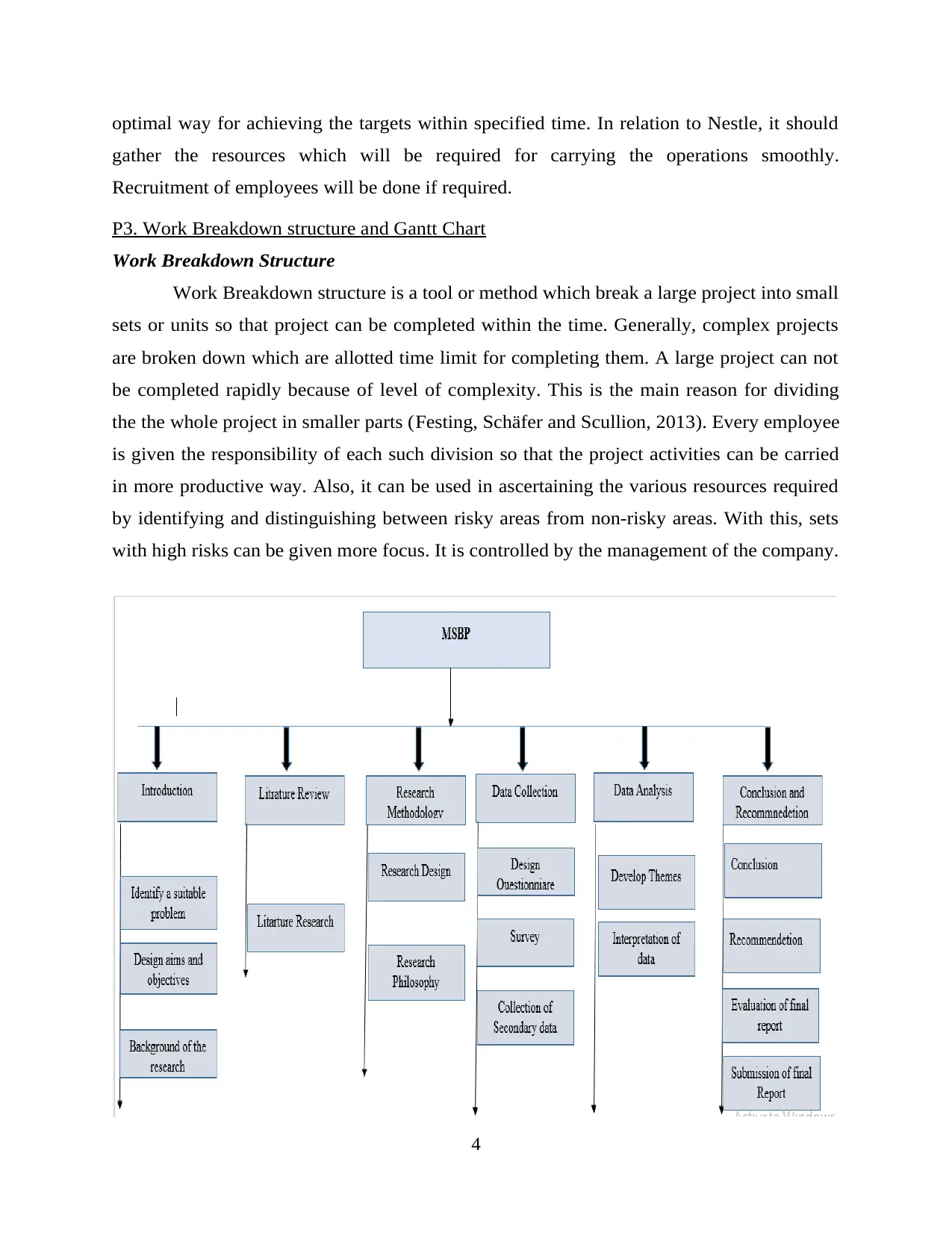
optimal way for achieving the targets within specified time. In relation to Nestle, it should
gather the resources which will be required for carrying the operations smoothly.
Recruitment of employees will be done if required.
P3. Work Breakdown structure and Gantt Chart
Work Breakdown Structure
Work Breakdown structure is a tool or method which break a large project into small
sets or units so that project can be completed within the time. Generally, complex projects
are broken down which are allotted time limit for completing them. A large project can not
be completed rapidly because of level of complexity. This is the main reason for dividing
the the whole project in smaller parts (Festing, Schäfer and Scullion, 2013). Every employee
is given the responsibility of each such division so that the project activities can be carried
in more productive way. Also, it can be used in ascertaining the various resources required
by identifying and distinguishing between risky areas from non-risky areas. With this, sets
with high risks can be given more focus. It is controlled by the management of the company.
4
gather the resources which will be required for carrying the operations smoothly.
Recruitment of employees will be done if required.
P3. Work Breakdown structure and Gantt Chart
Work Breakdown Structure
Work Breakdown structure is a tool or method which break a large project into small
sets or units so that project can be completed within the time. Generally, complex projects
are broken down which are allotted time limit for completing them. A large project can not
be completed rapidly because of level of complexity. This is the main reason for dividing
the the whole project in smaller parts (Festing, Schäfer and Scullion, 2013). Every employee
is given the responsibility of each such division so that the project activities can be carried
in more productive way. Also, it can be used in ascertaining the various resources required
by identifying and distinguishing between risky areas from non-risky areas. With this, sets
with high risks can be given more focus. It is controlled by the management of the company.
4
⊘ This is a preview!⊘
Do you want full access?
Subscribe today to unlock all pages.

Trusted by 1+ million students worldwide
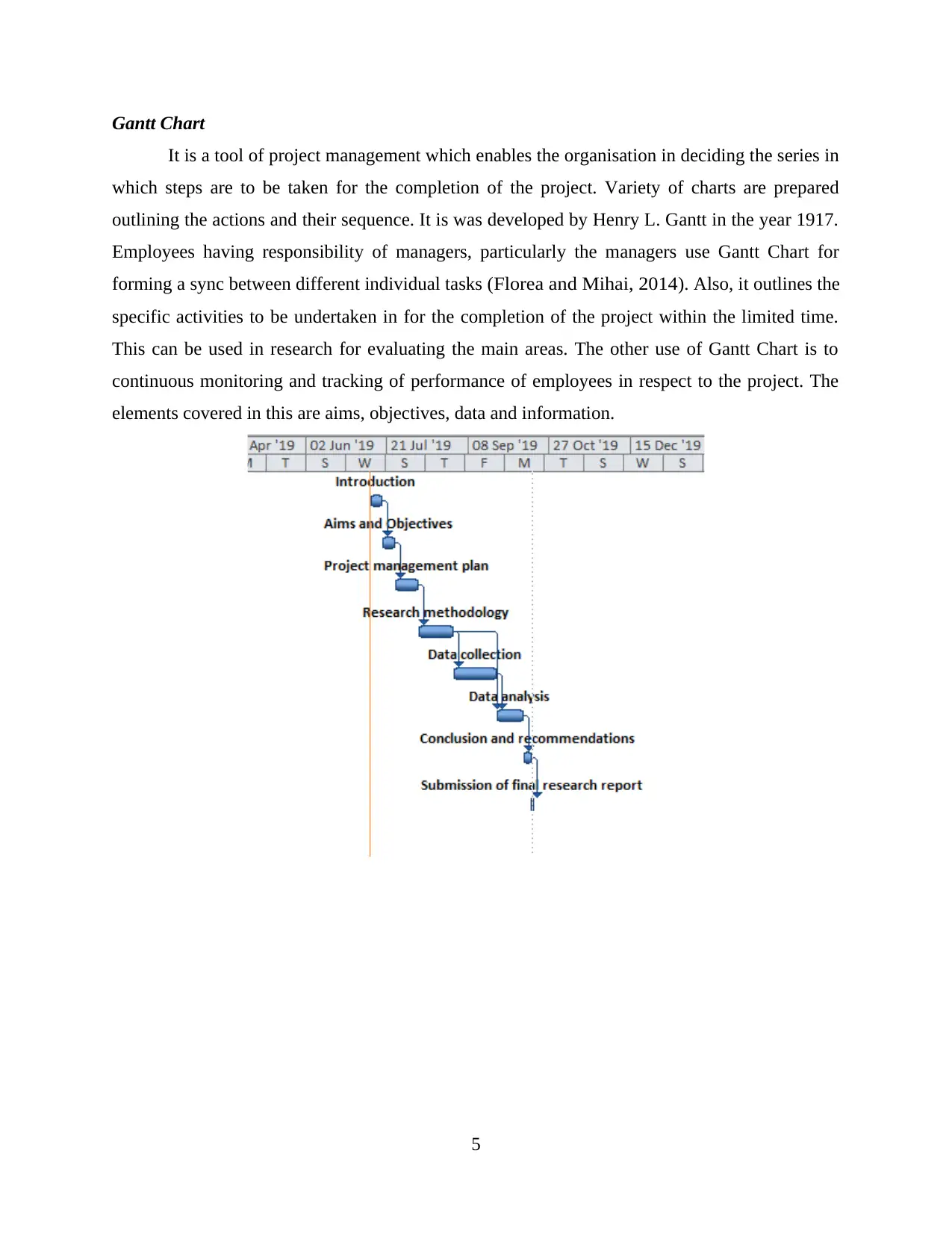
Gantt Chart
It is a tool of project management which enables the organisation in deciding the series in
which steps are to be taken for the completion of the project. Variety of charts are prepared
outlining the actions and their sequence. It is was developed by Henry L. Gantt in the year 1917.
Employees having responsibility of managers, particularly the managers use Gantt Chart for
forming a sync between different individual tasks ( Florea and Mihai, 2014). Also, it outlines the
specific activities to be undertaken in for the completion of the project within the limited time.
This can be used in research for evaluating the main areas. The other use of Gantt Chart is to
continuous monitoring and tracking of performance of employees in respect to the project. The
elements covered in this are aims, objectives, data and information.
5
It is a tool of project management which enables the organisation in deciding the series in
which steps are to be taken for the completion of the project. Variety of charts are prepared
outlining the actions and their sequence. It is was developed by Henry L. Gantt in the year 1917.
Employees having responsibility of managers, particularly the managers use Gantt Chart for
forming a sync between different individual tasks ( Florea and Mihai, 2014). Also, it outlines the
specific activities to be undertaken in for the completion of the project within the limited time.
This can be used in research for evaluating the main areas. The other use of Gantt Chart is to
continuous monitoring and tracking of performance of employees in respect to the project. The
elements covered in this are aims, objectives, data and information.
5
Paraphrase This Document
Need a fresh take? Get an instant paraphrase of this document with our AI Paraphraser
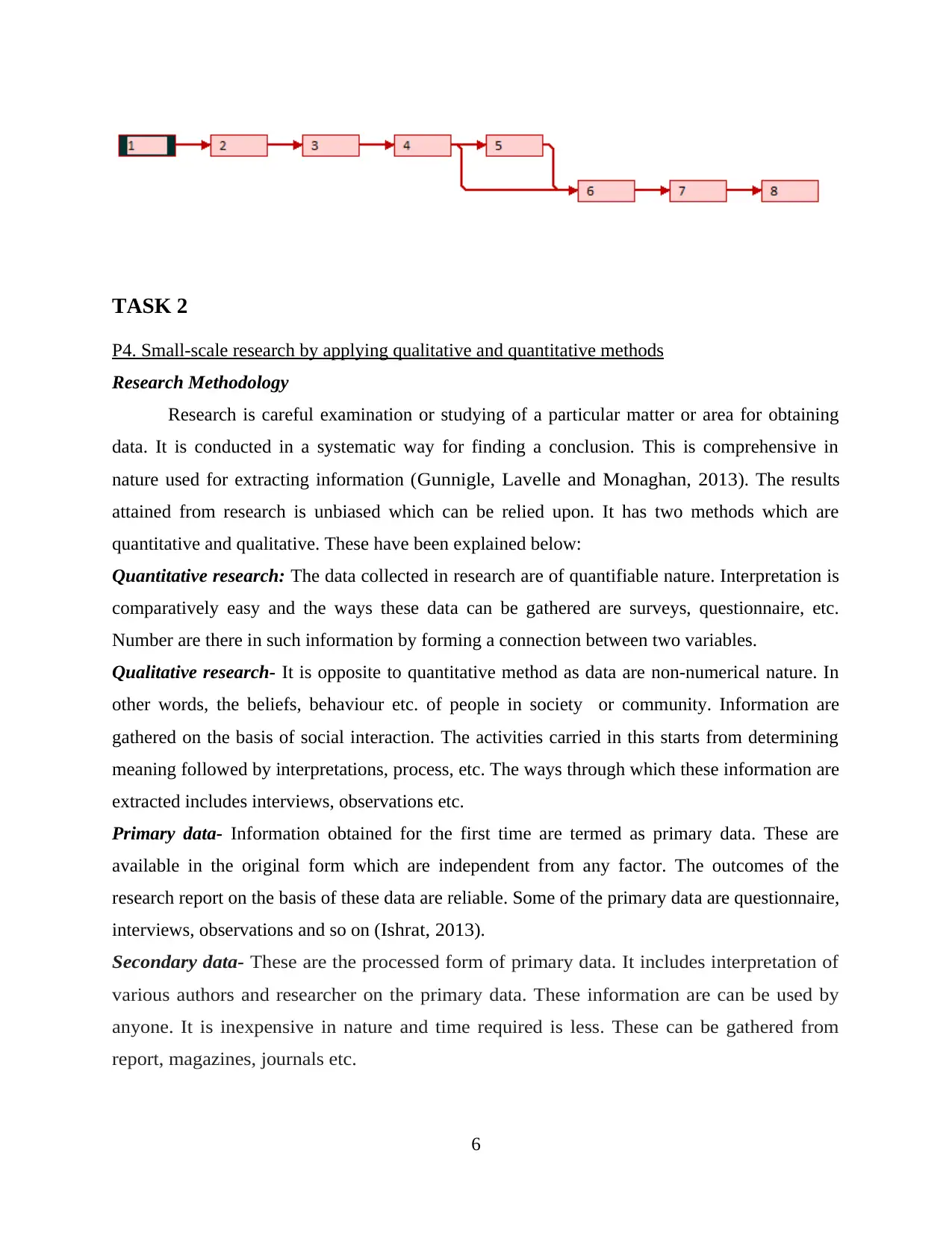
TASK 2
P4. Small-scale research by applying qualitative and quantitative methods
Research Methodology
Research is careful examination or studying of a particular matter or area for obtaining
data. It is conducted in a systematic way for finding a conclusion. This is comprehensive in
nature used for extracting information ( Gunnigle, Lavelle and Monaghan, 2013). The results
attained from research is unbiased which can be relied upon. It has two methods which are
quantitative and qualitative. These have been explained below:
Quantitative research: The data collected in research are of quantifiable nature. Interpretation is
comparatively easy and the ways these data can be gathered are surveys, questionnaire, etc.
Number are there in such information by forming a connection between two variables.
Qualitative research- It is opposite to quantitative method as data are non-numerical nature. In
other words, the beliefs, behaviour etc. of people in society or community. Information are
gathered on the basis of social interaction. The activities carried in this starts from determining
meaning followed by interpretations, process, etc. The ways through which these information are
extracted includes interviews, observations etc.
Primary data- Information obtained for the first time are termed as primary data. These are
available in the original form which are independent from any factor. The outcomes of the
research report on the basis of these data are reliable. Some of the primary data are questionnaire,
interviews, observations and so on ( Ishrat, 2013).
Secondary data- These are the processed form of primary data. It includes interpretation of
various authors and researcher on the primary data. These information are can be used by
anyone. It is inexpensive in nature and time required is less. These can be gathered from
report, magazines, journals etc.
6
P4. Small-scale research by applying qualitative and quantitative methods
Research Methodology
Research is careful examination or studying of a particular matter or area for obtaining
data. It is conducted in a systematic way for finding a conclusion. This is comprehensive in
nature used for extracting information ( Gunnigle, Lavelle and Monaghan, 2013). The results
attained from research is unbiased which can be relied upon. It has two methods which are
quantitative and qualitative. These have been explained below:
Quantitative research: The data collected in research are of quantifiable nature. Interpretation is
comparatively easy and the ways these data can be gathered are surveys, questionnaire, etc.
Number are there in such information by forming a connection between two variables.
Qualitative research- It is opposite to quantitative method as data are non-numerical nature. In
other words, the beliefs, behaviour etc. of people in society or community. Information are
gathered on the basis of social interaction. The activities carried in this starts from determining
meaning followed by interpretations, process, etc. The ways through which these information are
extracted includes interviews, observations etc.
Primary data- Information obtained for the first time are termed as primary data. These are
available in the original form which are independent from any factor. The outcomes of the
research report on the basis of these data are reliable. Some of the primary data are questionnaire,
interviews, observations and so on ( Ishrat, 2013).
Secondary data- These are the processed form of primary data. It includes interpretation of
various authors and researcher on the primary data. These information are can be used by
anyone. It is inexpensive in nature and time required is less. These can be gathered from
report, magazines, journals etc.
6
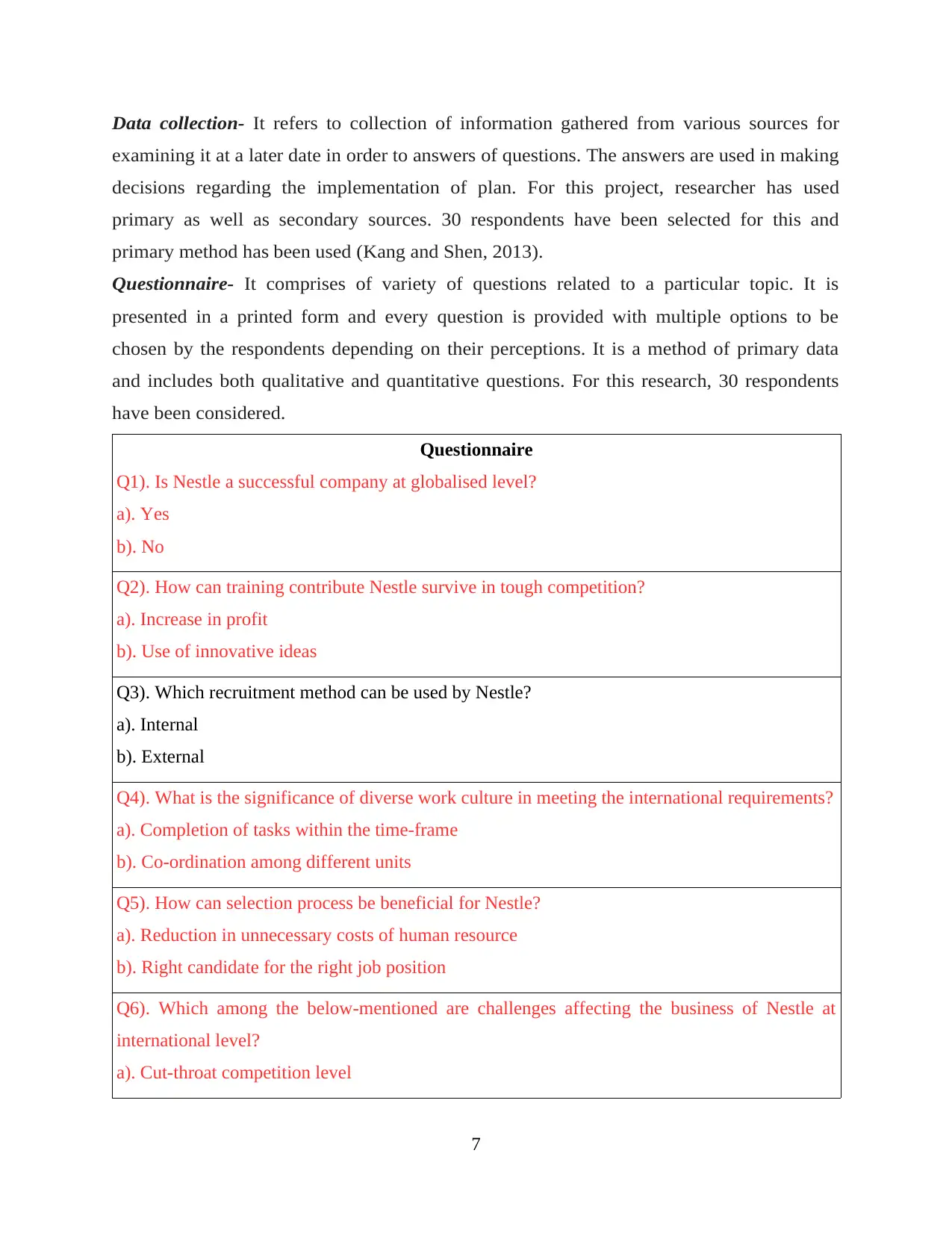
Data collection- It refers to collection of information gathered from various sources for
examining it at a later date in order to answers of questions. The answers are used in making
decisions regarding the implementation of plan. For this project, researcher has used
primary as well as secondary sources. 30 respondents have been selected for this and
primary method has been used (Kang and Shen, 2013).
Questionnaire- It comprises of variety of questions related to a particular topic. It is
presented in a printed form and every question is provided with multiple options to be
chosen by the respondents depending on their perceptions. It is a method of primary data
and includes both qualitative and quantitative questions. For this research, 30 respondents
have been considered.
Questionnaire
Q1). Is Nestle a successful company at globalised level?
a). Yes
b). No
Q2). How can training contribute Nestle survive in tough competition?
a). Increase in profit
b). Use of innovative ideas
Q3). Which recruitment method can be used by Nestle?
a). Internal
b). External
Q4). What is the significance of diverse work culture in meeting the international requirements?
a). Completion of tasks within the time-frame
b). Co-ordination among different units
Q5). How can selection process be beneficial for Nestle?
a). Reduction in unnecessary costs of human resource
b). Right candidate for the right job position
Q6). Which among the below-mentioned are challenges affecting the business of Nestle at
international level?
a). Cut-throat competition level
7
examining it at a later date in order to answers of questions. The answers are used in making
decisions regarding the implementation of plan. For this project, researcher has used
primary as well as secondary sources. 30 respondents have been selected for this and
primary method has been used (Kang and Shen, 2013).
Questionnaire- It comprises of variety of questions related to a particular topic. It is
presented in a printed form and every question is provided with multiple options to be
chosen by the respondents depending on their perceptions. It is a method of primary data
and includes both qualitative and quantitative questions. For this research, 30 respondents
have been considered.
Questionnaire
Q1). Is Nestle a successful company at globalised level?
a). Yes
b). No
Q2). How can training contribute Nestle survive in tough competition?
a). Increase in profit
b). Use of innovative ideas
Q3). Which recruitment method can be used by Nestle?
a). Internal
b). External
Q4). What is the significance of diverse work culture in meeting the international requirements?
a). Completion of tasks within the time-frame
b). Co-ordination among different units
Q5). How can selection process be beneficial for Nestle?
a). Reduction in unnecessary costs of human resource
b). Right candidate for the right job position
Q6). Which among the below-mentioned are challenges affecting the business of Nestle at
international level?
a). Cut-throat competition level
7
⊘ This is a preview!⊘
Do you want full access?
Subscribe today to unlock all pages.

Trusted by 1+ million students worldwide
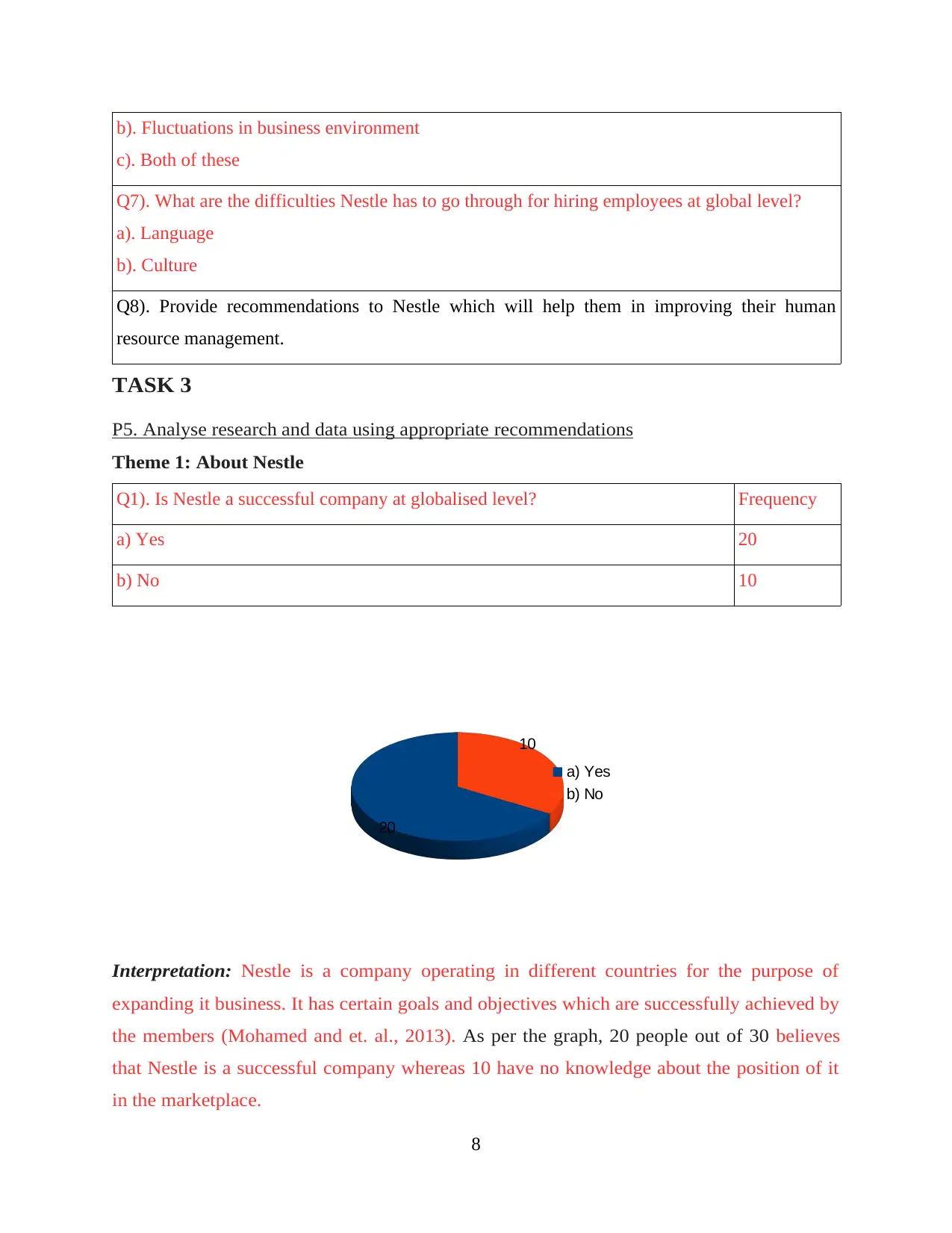
b). Fluctuations in business environment
c). Both of these
Q7). What are the difficulties Nestle has to go through for hiring employees at global level?
a). Language
b). Culture
Q8). Provide recommendations to Nestle which will help them in improving their human
resource management.
TASK 3
P5. Analyse research and data using appropriate recommendations
Theme 1: About Nestle
Q1). Is Nestle a successful company at globalised level? Frequency
a) Yes 20
b) No 10
Interpretation: Nestle is a company operating in different countries for the purpose of
expanding it business. It has certain goals and objectives which are successfully achieved by
the members (Mohamed and et. al., 2013). As per the graph, 20 people out of 30 believes
that Nestle is a successful company whereas 10 have no knowledge about the position of it
in the marketplace.
8
20
10
a) Yes
b) No
c). Both of these
Q7). What are the difficulties Nestle has to go through for hiring employees at global level?
a). Language
b). Culture
Q8). Provide recommendations to Nestle which will help them in improving their human
resource management.
TASK 3
P5. Analyse research and data using appropriate recommendations
Theme 1: About Nestle
Q1). Is Nestle a successful company at globalised level? Frequency
a) Yes 20
b) No 10
Interpretation: Nestle is a company operating in different countries for the purpose of
expanding it business. It has certain goals and objectives which are successfully achieved by
the members (Mohamed and et. al., 2013). As per the graph, 20 people out of 30 believes
that Nestle is a successful company whereas 10 have no knowledge about the position of it
in the marketplace.
8
20
10
a) Yes
b) No
Paraphrase This Document
Need a fresh take? Get an instant paraphrase of this document with our AI Paraphraser
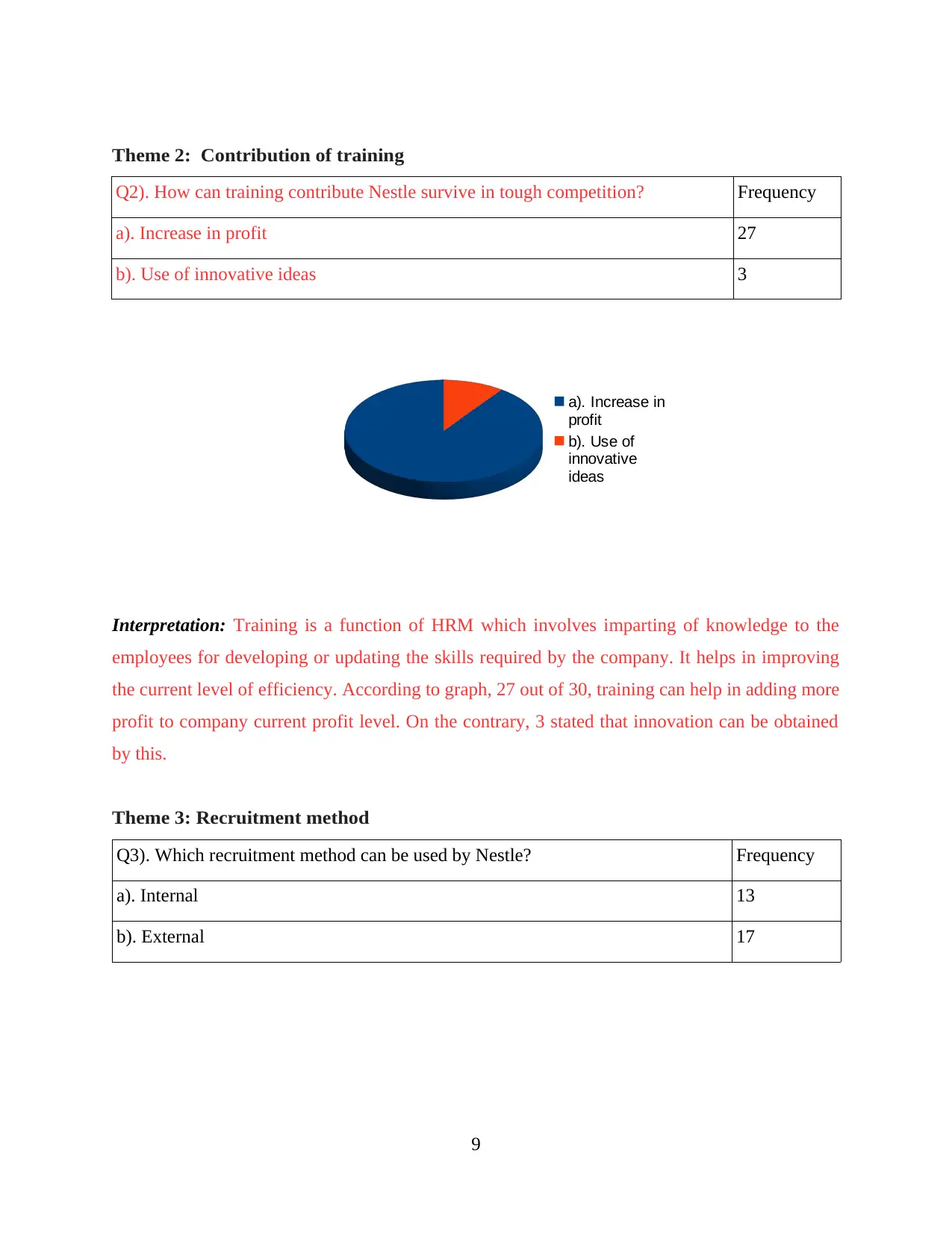
Theme 2: Contribution of training
Q2). How can training contribute Nestle survive in tough competition? Frequency
a). Increase in profit 27
b). Use of innovative ideas 3
Interpretation: Training is a function of HRM which involves imparting of knowledge to the
employees for developing or updating the skills required by the company. It helps in improving
the current level of efficiency. According to graph, 27 out of 30, training can help in adding more
profit to company current profit level. On the contrary, 3 stated that innovation can be obtained
by this.
Theme 3: Recruitment method
Q3). Which recruitment method can be used by Nestle? Frequency
a). Internal 13
b). External 17
9
a). Increase in
profit
b). Use of
innovative
ideas
Q2). How can training contribute Nestle survive in tough competition? Frequency
a). Increase in profit 27
b). Use of innovative ideas 3
Interpretation: Training is a function of HRM which involves imparting of knowledge to the
employees for developing or updating the skills required by the company. It helps in improving
the current level of efficiency. According to graph, 27 out of 30, training can help in adding more
profit to company current profit level. On the contrary, 3 stated that innovation can be obtained
by this.
Theme 3: Recruitment method
Q3). Which recruitment method can be used by Nestle? Frequency
a). Internal 13
b). External 17
9
a). Increase in
profit
b). Use of
innovative
ideas
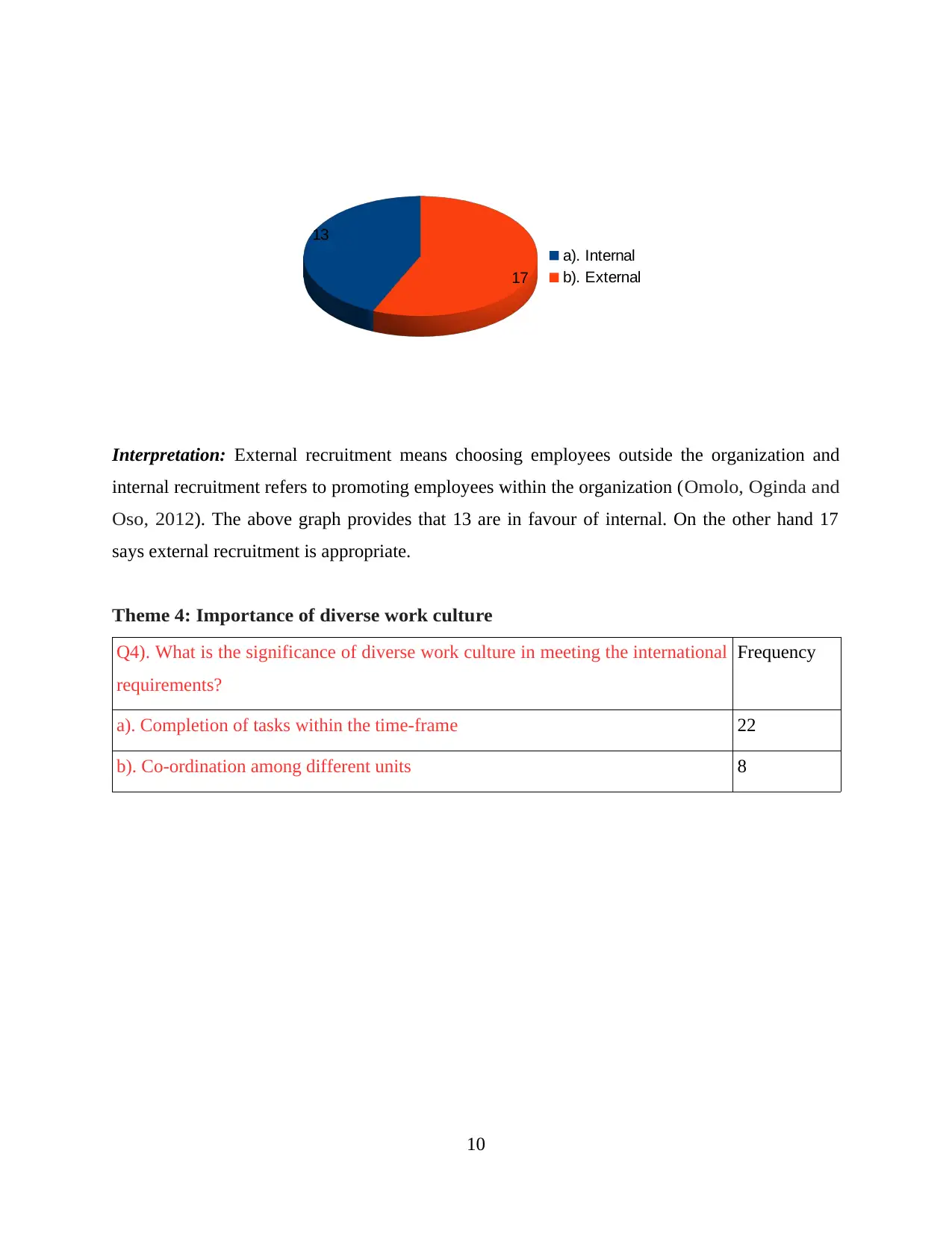
Interpretation: External recruitment means choosing employees outside the organization and
internal recruitment refers to promoting employees within the organization ( Omolo, Oginda and
Oso, 2012). The above graph provides that 13 are in favour of internal. On the other hand 17
says external recruitment is appropriate.
Theme 4: Importance of diverse work culture
Q4). What is the significance of diverse work culture in meeting the international
requirements?
Frequency
a). Completion of tasks within the time-frame 22
b). Co-ordination among different units 8
10
13
17
a). Internal
b). External
internal recruitment refers to promoting employees within the organization ( Omolo, Oginda and
Oso, 2012). The above graph provides that 13 are in favour of internal. On the other hand 17
says external recruitment is appropriate.
Theme 4: Importance of diverse work culture
Q4). What is the significance of diverse work culture in meeting the international
requirements?
Frequency
a). Completion of tasks within the time-frame 22
b). Co-ordination among different units 8
10
13
17
a). Internal
b). External
⊘ This is a preview!⊘
Do you want full access?
Subscribe today to unlock all pages.

Trusted by 1+ million students worldwide
1 out of 21
Related Documents
Your All-in-One AI-Powered Toolkit for Academic Success.
+13062052269
info@desklib.com
Available 24*7 on WhatsApp / Email
![[object Object]](/_next/static/media/star-bottom.7253800d.svg)
Unlock your academic potential
Copyright © 2020–2025 A2Z Services. All Rights Reserved. Developed and managed by ZUCOL.





